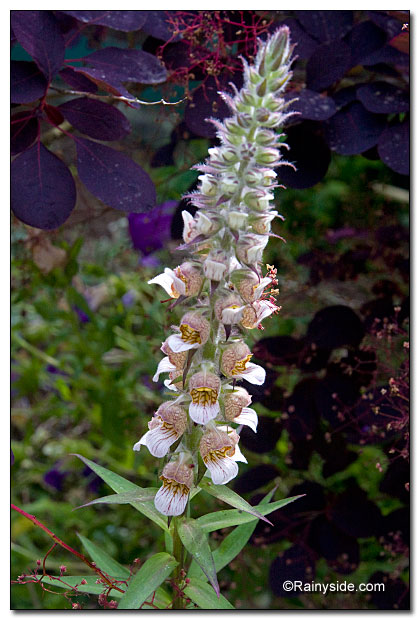Digitalis lanata
GRECIAN FOXGLOVE, WOOLLY FOXGLOVE, AUSTRIAN FOXGLOVE
Family: Plantaginaceae
Pronounced: dig-ee-TAH-liss la-NA-tuh
Quick Jumps
Growing Guide
Rainy Side Notes
GROWING GUIDE

Origin:
Balkans, Hungry, Italy, Turkey.
Plant Group:
Biennials.
Hardiness:
Sunset zones: 2b-10, 14-24.
USDA zones: 3-9.
Heat zones:9-1.
Mature size:
Height: 24 inches (60 cm).
Width: 12 inches (30 cm).
Flowering period:
Mid- to late summer.
Flowering attributes:
Racemes of creamy-white to tan flowers with violet-brown veining in the throat.
Leaf attributes:
Mid-green, lance-shaped leaves.
Growth habit:
Clumping.
Light:
Partial shade to full sun.
Soil:
Humus rich, well-drained soil.
Feeding:
Use a complete organic fertilizer when planting, and the following spring, side dress plants.
Propagation Methods:
Sow seed in container or in situ.
Divide plants in spring and autumn.
Pruning Methods:
Deadhead blossoms to promote another year of flowers.
Rainy Side Notes
I grow this biennial along the street, where it receives little attention from me, very little water, and it still reseeds itself along with another biennial in the same garden—Canterbury bells (Campanula medium 'Calycanthema').
Digitalis can behave more like a short-lived perennial, if you prune the flower stems off before it sets seed. You can sacrifice one plant by letting it go to seed, and deadhead all the others to prolong their life for another year. Although D. lanata’s flowers aren’t as blousy as D. purpurea’s, they are still lovely in a quieter way.
The name Digitalis comes from the Latin word digitus, which means finger, because of its finger-like flowers. Lanata means woolly, referring to its racemes.
This plant has life-saving properties. Because of D. lanata's higher potency of digoxin, it beat D. purpurea out of its medicinal job in the pharmaceutical industry. As beautiful as this biennial is, it is a dangerous plant—extremely poisonous—and should never be ingested. Death has come even from doctor prescribed medications that were too strong for the patient. Although accidental poisoning by humans or animals is very rare, the plant has been used to commit suicide and murder.
Debbie Teashon
Photographed in author's garden.

Gardening for the Homebrewer: Grow and Process Plants for Making Beer, Wine, Gruit, Cider, Perry, and More
By co-authors Debbie Teashon (Rainy Side Gardeners) and Wendy Tweton
Copyright Notice | Home | Search | Annuals

